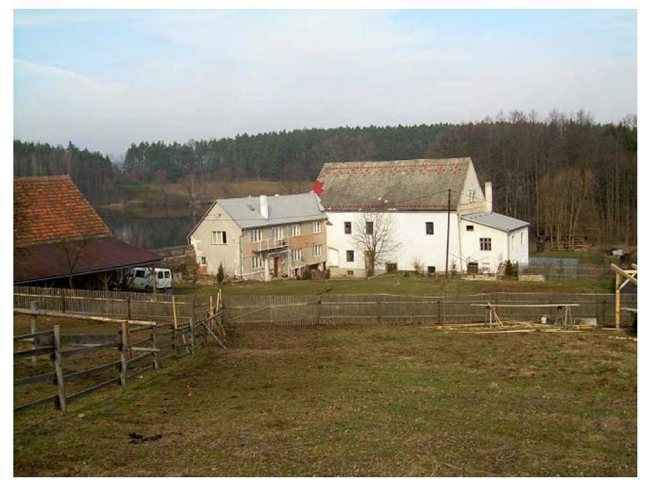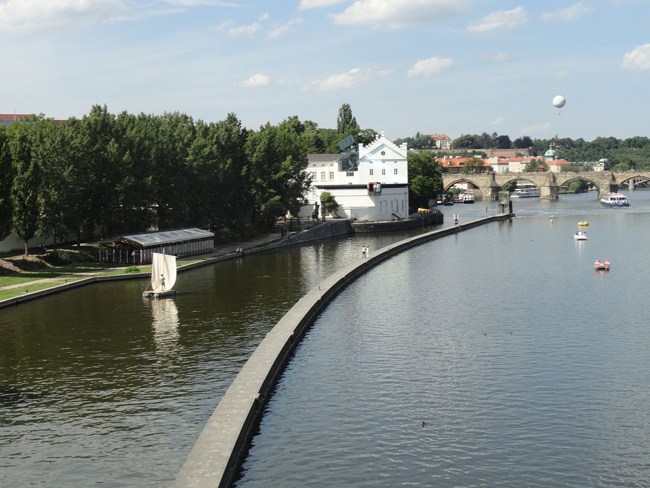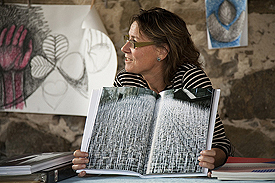ArtMill: Global Change Inspired from a Seed Planted in the Czech Countryside

In 2004, Barbara Benish founded the NGO Art Dialogue, which, among other things, supports programs and a farm at ArtMill, a renovated flourmill and granary from the 17th century located in the forested countryside bordering Šumava National Park (one of the largest remaining greenbelts in Europe). Positioned on a lake, ArtMill has become an international destination for artists, scientists, environmentalists, writers and students of all ages to study, collaborate and create. The rural property consists of living quarters, renovated studio structures, barns, outdoor workspaces and organic gardens. This text is adapted from conversations between Benish and Janeil Engelstad between 2012 and 2014.
Art Dialogue officially started in 2004, but theidea actually began with the exhibition Dialogue: Prague/Los Angeles, co-organized in 1989 with Zdenka Gabalová. It was the first time that Czech, Slovak and American art had been shown together in an international exhibition in fifty years. This was right before the Velvet Revolution, when communism was starting to break apart and open up. We brought twelve American artists to Prague, exhibiting their work under heavy police surveillance. The atmosphere was politically hot. People in the art community did not believe that there could be an exchange whereby Czech and Slovak artists could travel to the States for the Los Angeles piece of the exhibition. None of the participating artists had passports, and as much of the work they produced was deemed subversive by the state, exhibiting it was illegal. But then the Berlin Wall came down, everything rapidly changed and the exchange became politically possible.
 ArtMill, which is under the umbrella of Art Dialogue, was founded in response to the realization that there was a unique opportunity to offer space and new ways for sharing information and ideas away from an urban center, in the middle of the Czech countryside. Czech artist Ivan Kafka says that you cannot teach art, but you can put together an atmosphere where people’s creativity is developed. Providing a physical and mental space where people can take the time to ponder and actually make something takes away the focus on the object. It becomes about the process. This is what we began to do at ArtMill.
ArtMill, which is under the umbrella of Art Dialogue, was founded in response to the realization that there was a unique opportunity to offer space and new ways for sharing information and ideas away from an urban center, in the middle of the Czech countryside. Czech artist Ivan Kafka says that you cannot teach art, but you can put together an atmosphere where people’s creativity is developed. Providing a physical and mental space where people can take the time to ponder and actually make something takes away the focus on the object. It becomes about the process. This is what we began to do at ArtMill.
Our first program was a summer camp where we taught ecology, history and other subjects via art projects. There was a historical tradition in communist Czechoslovakia where people would get together and go camping in the wilderness to teach their children music, art, and nature. ArtMill’s camp was inspired by this history. Czechs in general have a strong connection to nature as the country was not industrialized until very late, and it is no great leap of the imagination for contemporary artists to be so closely engaged with environmental issues. Our programs expanded organically to include an artist’s residency, art and environmental workshops, and programs for high school and college students. Hundreds of artists, students, activists, and thinkers from around the world have visited and contributed to ArtMill’s vision, including Kim Abeles (USA), Keiji Shinohara (Japan), Melissa Briceno Cervera, Rodrigo Quinones Reyes, and Daniel Camacho (Mexico), and Lisa Wulff (Norway). Visitors have also included international scientists and diplomats working at the UN on hazardous chemicals and wastes; and writers from Prague, Hawaii, and Great Britain.
Czech conceptual artist Martin Zet, whose performances and installations challenge the perception of the environment at a fundamental level by inviting us to not just see the beauty of a place, but to engage in it physically, led students on a memorable walk around the lake. The students were asked to take a long stick and nothing else with them. The stick acted as a tool, a weapon, and a guide, for each of these generally nonrural participants who hiked, jumped, and swam their way around a new ecosystem. Forced to engage with the surrounding environment, they came back to the Mill three hours after setting off, exhausted, but changed. The participants had experienced Nature first hand. Martin also walked through the surrounding cornfields on stilts, giving the illusion from afar that he was floating or walking on air through the tall stalks. It was both otherworldly and humorous, in the best tradition of Czech heritage, famous for its black humor, surrealism, and alchemical traditions.
 Vladimir Kokolia was Artist-in-Residence in 2006. His lecture on the chemistry of water and its molecular structure was almost as inspirational as his performance in nature. For three days and nights, he floated on a raft on the lake at ArtMill, while the children at summer camp created flags for his raft that he could raise in time of need: symbolic images for food, postal services, a shark attack notice, musical time-outs, and the inevitable call for first aid were all a part of this performance. The entire performance cycle went from sunrise to sunset, beginning with a tai-chi dance in the middle of the mist-covered lake, as Kokolia throughout the day raised a particular flag to call the children to perform a task. This lasted until the evening meal that would be delivered by canoe and shared afloat the raft.
Vladimir Kokolia was Artist-in-Residence in 2006. His lecture on the chemistry of water and its molecular structure was almost as inspirational as his performance in nature. For three days and nights, he floated on a raft on the lake at ArtMill, while the children at summer camp created flags for his raft that he could raise in time of need: symbolic images for food, postal services, a shark attack notice, musical time-outs, and the inevitable call for first aid were all a part of this performance. The entire performance cycle went from sunrise to sunset, beginning with a tai-chi dance in the middle of the mist-covered lake, as Kokolia throughout the day raised a particular flag to call the children to perform a task. This lasted until the evening meal that would be delivered by canoe and shared afloat the raft.
In 2010, Hungarian artist Ilona Nemeth, who is based in Bratislava, presented a challenging series of works based on Central European identity at our regional exhibition space, Galerie Califia (Califia is also operated under the Art Dialogue umbrella). A series of exhibited maps of Central Europe, videos, and grave markers asked the public to answer the question “Where is my Home?,” which is also the title of the Czech National Anthem.
Artists Kristyna and Marek Milde (CZ/USA) installed their call to environmental attention with their work In Tree Net (2010), also at Galerie Califia. Utilizing branches from the local forest, the installation presented the tension and differences between the natural and the industrial world. A series of branch/utility lines graced the gallery ceiling and walls, studded by typical radiator fixtures, causing a mental pause in the viewer’s attention. The branches mimicked radiator pipes, or electric cables, running near the floor. This wryly humorous work was both profound and satirical, classically Czech-Slovakian in its tongue-in-cheek humor, and referenced both the connection to nature, as well as the antiquated and obsolete infrastructures of housing and plumbing in this part of the world.
 In 2010, after many years of teaching both American students and then international kids at ArtMill, I began to feel that creativity is no longer a given, and in fact is becoming a rare jewel. This led to further research and a new curriculum reflecting both the UN and UNESCO shifts towards acknowledging culture as a driver of sustainable development, and to promoting creativity as a pillar towards the United Nation’s Millennium Development Goals. ArtMill’s programs began to reflect these contemporary ideas that creativity may no longer be sustainable and, therefore, needs to be protected and nurtured like a nature reserve. At about this time we expanded our school’s name to ArtMill Center for Sustainable Creativity. Creativity used to be an educational value that was an integral part of learning, inherent in the humanities as well as the sciences, but that’s no longer the case, especially in the U.S.. I wanted to develop new, creative ways to broaden knowledge and information about ecology and environmental issues via the arts. About this time I was also invited to participate as an advisor to the United Nations’ Safe Planet Campaign for the Responsibility of Hazardous Chemicals and Wastes, under the auspices of the Basel, Rotterdam and Stockholm Conventions. Environmental research, education and outreach began to cross over into a very exciting international platform as we traveled to various countries to exhibit works of art on issues of electronic waste, plastic pollution, and other chemical toxins. ArtMill became an experimental lab for art and thinking about the ecology of our planet in new experiential and visual ways. This research continues with a new book on eco-art I’m writing with the French sociologist Nathalie Blanc for the COST group in Europe, who are working to bring culture and the arts into the international dialogue for a sustainable future.
In 2010, after many years of teaching both American students and then international kids at ArtMill, I began to feel that creativity is no longer a given, and in fact is becoming a rare jewel. This led to further research and a new curriculum reflecting both the UN and UNESCO shifts towards acknowledging culture as a driver of sustainable development, and to promoting creativity as a pillar towards the United Nation’s Millennium Development Goals. ArtMill’s programs began to reflect these contemporary ideas that creativity may no longer be sustainable and, therefore, needs to be protected and nurtured like a nature reserve. At about this time we expanded our school’s name to ArtMill Center for Sustainable Creativity. Creativity used to be an educational value that was an integral part of learning, inherent in the humanities as well as the sciences, but that’s no longer the case, especially in the U.S.. I wanted to develop new, creative ways to broaden knowledge and information about ecology and environmental issues via the arts. About this time I was also invited to participate as an advisor to the United Nations’ Safe Planet Campaign for the Responsibility of Hazardous Chemicals and Wastes, under the auspices of the Basel, Rotterdam and Stockholm Conventions. Environmental research, education and outreach began to cross over into a very exciting international platform as we traveled to various countries to exhibit works of art on issues of electronic waste, plastic pollution, and other chemical toxins. ArtMill became an experimental lab for art and thinking about the ecology of our planet in new experiential and visual ways. This research continues with a new book on eco-art I’m writing with the French sociologist Nathalie Blanc for the COST group in Europe, who are working to bring culture and the arts into the international dialogue for a sustainable future.
With the Safe Planet campaign we are working to demonstrate and visualize how toxins and chemical waste are affecting our bodies, as well as the planet. Our work includes showing people what is happening to our bodies with the Chemical Body Burden. There are at least eighty-two toxic chemicals that we all carry in our body. With Safe Planet we are working to understand where the chemicals come from, how they enter our bodies and how we can stop this from happening. We also work on persistent organic pollutants, plastic pollution, mercury pollution, and e-waste. There is a considerable amount of scientific information about these issues and our task is to help the general public access that information and help them understand how chemicals and hazardous waste are impacting our lives. Scientists rarely have the resources for outreach, and often they don’t have access to the public. Art is a way to deliver the science of these topics in a way that people understand. Read more information here
We aim to not just illustrate science but to research how creativity can create change. To that end, Art Dialogue is working with several UN initiatives on the expansion of the UN program Sustainable Development Goals that reflect the importance of arts and culture in this work. Our activities at UN conferences and other events allow us to articulate our experience with farming and teaching at ArtMill over the years into a model that can bring creative, local economies into a sustainable future. Working through the arts, we are able to get people excited about these ideas and to come together to create positive change.

 Barbara Benish has shown in numerous international exhibitions, from P.S.1 Museum in New York to alternative spaces in Europe and the Middle East. She is represented in public and private collections, including The J. Paul Getty Museum; Stadtgeschichtliche Museen, Nürnberg; and the National Museum, Prague. In 2004, Benish founded the NGO Art Dialogue, based in Prague, which supports an artist-run gallery, summer study abroad programs, and an artist residency at ArtMill. She is a Fellow at the Social Practice Arts Research Center, University of California, Santa Cruz. Since 2011, her theoretical work has contributed to the UN Education Caucus and the Transformative Education Forum. See www.art-dialogue.org.
Barbara Benish has shown in numerous international exhibitions, from P.S.1 Museum in New York to alternative spaces in Europe and the Middle East. She is represented in public and private collections, including The J. Paul Getty Museum; Stadtgeschichtliche Museen, Nürnberg; and the National Museum, Prague. In 2004, Benish founded the NGO Art Dialogue, based in Prague, which supports an artist-run gallery, summer study abroad programs, and an artist residency at ArtMill. She is a Fellow at the Social Practice Arts Research Center, University of California, Santa Cruz. Since 2011, her theoretical work has contributed to the UN Education Caucus and the Transformative Education Forum. See www.art-dialogue.org.

